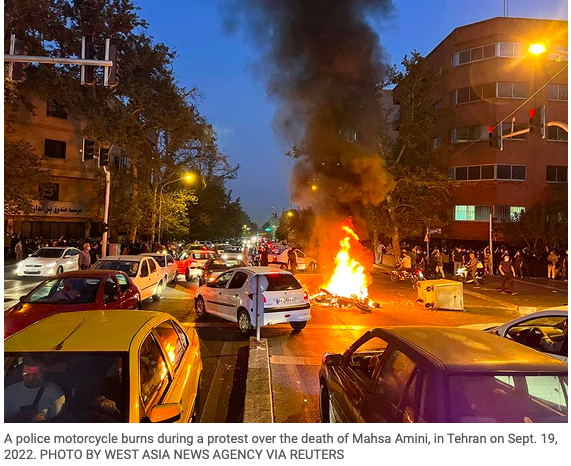Where do we stand as Canadians on Iran and its freedom movement?

Nazanin Afshin-Jam MacKay: The 2022 Iranian Revolution has begun. Will Canada stand with the people or the tyrants?
Canadians need to know that this regime poses a direct threat to their security
Article content
Mahsa Amini was a 22-year-old girl with hopes and dreams as vast and vibrant as an Iranian sunset. Iran’s “morality police” stopped her beautiful heart from beating because she dared not adhere to the strict dress code of the Islamic Republic of Iran. Officers deemed her pants to be “too tight” and her hijab “too loose.” Amini paid for these “offences” with her life.
The daughters and granddaughters of the ruling clerics, who control women’s bodies, can be seen at parties in L.A., dressed in miniskirts and high heels, raven hair flowing as freely as the Champagne they sip. The sons of mullahs parade down Hollywood Boulevard in gleaming Lamborghinis while shackled souls in Iran languish in poverty with three jobs just to make ends meet, and children of the street dwell in cardboard boxes.
Article content
Amini’s murder sparked a conflagration across Iran, where women threw their hijabs into flickering flames and cut their exposed hair in acts of defiance, with men righteously in support by their side. The malevolent regime uses the hijab as a tool of control. As Masih Alinejad, perhaps the loudest echo of resistance in this struggle, explains, the hijab is one of the remaining ideological pillars of the Islamic regime, and she likens its removal “to the crumbling of the Berlin Wall.”
Amini was an inmate in the prison of Iran. She was repressed and subjugated by draconian, misogynistic laws that she did not agree with, nor do the vast majority of the 86 million people living in the country. While the start of the protests were about women’s rights and a call to end the gender apartheid that exists in Iran — where it is written in the law that the life of a woman is worth half that of a man — it has shifted to something much greater.
What is dawning in Iran is no longer just #MahsaAmini. It is no longer #iranprotests. It is #IranRevolution2022. What we are witnessing is an accumulation of 44 years of oppressive theocratic rule, suppression of rights, and egregious abuses of human rights spilling into the streets of Iran.
What has led to this? Who are the victims?
Ethnic and religious minorities are being persecuted. Baha’i’s are denied the right to go to university or to obtain certain jobs. Their graves are even desecrated. Apostasy, converting from Islam to another religion, is a crime punishable by death in Iran. Sixteen-year-old Mona Mahmudnizhad remains in the hearts and memories of the Iranian people. She was tortured by being whipped on the soles of her feet and hanged in public because of her faith as a Baha’i. Over 160 children await their fates on death row in Iran. LGBTQ Iranians fear for their lives, and are among thousands of refugees who have fled the country. Freedom of expression is nonexistent. Dissenting journalists and lawyers defending their clients are incarcerated. Pre-eminent human rights attorney Nasrin Sotoudeh is serving her fourth year of a 10-year prison sentence for defending women who dared display their defiance by putting their hijabs on a stick.
Why are Iranians protesting now?
Iranian singer/songwriter Shervin Hajipour answers the question in a single song:
“Because of dancing in the streets, because of every time we were afraid to kiss our lovers in a street … Because of the embarrassment of an empty pocket, because of yearning for a normal life. Because of a child who picks through rubbish, and his dreams. Because of the fight for equality … Because of this polluted air, because of Vali Asr Avenue and its dying trees. Because of innocent, outlawed dogs … Because of the girl who wished she were a boy. Because of women, life, freedom.”
Hajipour addresses poverty, inequality, lack of liberty, and the political and social repression that the population faces, including discrimination against women and the corrupt mismanagement that runs rife throughout the regime. He speaks to the hopes and dreams of the young population unable to sing, dance or show public displays of affection. He laments the pollution and environmental devastation and disregard for endangered species — and for pets through the mass culls of dogs deemed as “unclean.”
The young singer composed his song “For” based on tweets from Iranians sharing why they are protesting. Regime officials forced him to delete it from his social media page and he was detained in prison. His haunting song has become an anthem for Iranians in these protests.
Article content
We are nearing four weeks into the protests that have been held in cities across Iran, drawing those from all walks of life, ages, socio-economic classes and ethnic groups. The regime has responded by unleashing its thugs, killing over 185 peaceful protesters so far, including at least 19 under the age of 18, and injuring thousands.
Random, indiscriminate shootings on the streets by government forces have been witnessed throughout the country. On Sept. 30, in what has been dubbed “https://www.amnesty.org.uk/press-releases/iran-least-82-protesters-and-bystanders-killed-bloody-crackdown-baluchistan", "layout_section": "in-page-link"}">Bloody Friday,” security forces killed 66 people, including children, in a crackdown outside a mosque in Zahedan after Friday prayers.
Sixteen-year-old Nika Shakarami was arrested during protests, beaten and killed. Her family was asked to identify her by a brief glance at her face. They buried her in their hometown. Regime authorities then stole her body and moved it without permission to a burial site 40 minutes away.
Twenty-year-old Hadis Najafi cried all night when she heard about Amini’s death and went out to protest. She was shot and died in the blood-streaked streets where she lay. Her sister said “now that they have killed my sister, I have nothing to lose, I am not afraid of anything.” That is the common sentiment throughout the country. The Iranian people, who dwell in the shadows of tyranny, are willing to die, just for a chance to live in the light of liberty. This includes students.
After a peaceful protest at Tehran’s elite Sharif University, students were barricaded inside, beaten, shot at and blindfolded before being taken to detention centres. One baby was shot at in a car and blinded, while countless others were killed by indiscriminate gunfire at the university. The next day, hundreds of schools and universities showed their anger in strikes. High school students were seen in videos closing the gates to their schools, shouting back at “morality police,” shooing and booing out their school principal, ripping the Ayatollah’s pictures off their classroom walls, burning their hijabs in plain daylight, and chanting “We don’t want the Islamic Republic” and “Down with the dictator.”
General strikes have started. On Monday, petrochemical workers went on strike at the Abadan refinery, which is symbolically significant as it played a key role in the toppling of the Shah of Iran in 1979. More strikes are on the horizon across all sectors of Iranian society — including in the bazaars. How long will protesters be able to sustain the strikes on their already meagre earnings? Once the regime brings in foreign mercenaries to do its murderous bidding, there will be an exponential increase in bloodshed.
We have seen even more brutality unleashed on the streets in the past few days, including videos of a woman being beaten with a baton despite her plea to her attacker that she was pregnant. A young man, Darius Alizadeh, was shot dead in his car simply for honking in support of protesters. His mother’s message was, “Don’t offer condolences. Continue the uprising.”
Article content
Areas of Kurdistan, including Sanandaj, looked like a war zone on Monday night with tanks and heavy artillery rolling in and shelling homes. The list of deaths that was being compiled included that of a seven-year-old girl.
It is urgent that the international community comes to the aid of Iranians.
Heads of state can act expeditiously when there is political will, as seen with the war on Ukraine, but who does one turn to when one’s government is massacring its own people? Iranians turn to the UN and hear the chirping of crickets.
Iranians are not demanding the UN enforce its Responsibility to Protect (R2P) principle with boots on the ground, but at the very least they expect emergency meetings to be held on the disproportionate use of force against and indiscriminate killings of peaceful Iranians, resulting in some form of action and clear condemnation. There has been nothing of consequence yet.
Article content
If the deaths of innocents alone are not enough to spark action, the world community must understand that it is in its self interest to support Iran’s freedom movement. Permitting this regime to stay in power jeopardizes all of our lives. The regime is irrational, unstable and dangerous. Supreme Leader Ayatollah Khamenei has quoted the founder of the Islamic regime, asking dissidents to turn themselves in to authorities to face execution so that they will be saved from Allah’s wrath in the afterlife.
We are all in peril if this regime develops nuclear weapons. The religious fanatics in power believe in the coming of the 12th Imam, the Mahdi who will appear at a time of great destruction, to bring salvation to the people. They do not fear a nuclear holocaust, they do not fear an end to the world, in fact … they welcome it.
Article content
Western nations need to decide whether they are on the side of the tyrannical regime, or on the right side of history, supporting a people who want freedom and democracy. Siding with the latter ensures a stable Iran and a more stable Middle East. A world devoid of the Iranian regime will deprive proxy terrorist groups like Hamas in Palestine, Hezbollah in Lebanon, the Houthis in Yemen, Shia militants in Iraq, and Assad’s regime in Syria, of their primary source of funding.
It will also deprive Russia of the Iranian missiles and drones that Ukrainian President Volodymyr Zelenskyy said on Monday were being used in the attacks on his people.
How do we help the Iranian people, what can Canada do, what can Canadians do?
What can Canadians do?
Canadians need to know that this regime poses a direct threat to their security. Canada is harbouring regime agents inside our borders and has been one of the main havens for their laundered money through the purchasing of assets, companies and properties. They have been directly involved in harassing and spying on Iranians in Canada. They have even invited militant First Nations groups to Tehran for “talks.”
Article content
On Oct. 1, protests were co-ordinated in over 150 cities worldwide by Hamed Esmaeilion, an Iranian-Canadian dentist whose wife and young daughter were killed in Flight PS752, the Ukrainian civilian aircraft downed by Iran’s Islamic Revolutionary Guard Corps (IRGC), killing all 176 people on board, including 55 Canadian citizens and 30 permanent residents. In Toronto alone, more than 50,000 came out to protest and support Iran’s freedom movement.
If Prime Minister Justin Trudeau had been interested in learning how to help, and to show his solidarity, he would have attended one of the rallies across Canada to hear what Iranian-Canadians had to say. Instead, he went bungee jumping that weekend and offered to light up Parliament in Iran’s tri-colours for a couple of days.
Article content
The Iranian Canadian community did not relent and kept up the pressure. They relayed to the government that the overarching request of freedom rally participants was for Western nations to stop legitimizing this regime. The regime does not represent the people of Iran. Those in power were never elected in free or fair elections.
We must adopt Magnitsky sanctions to oust regime officials, and their families, from Canada. The Trudeau government made a good first step on Friday by announcing it is bringing in tough new immigration measures that will result in more than 10,000 members of the IRGC being barred from Canada, although it was unclear if those already here will be expelled.
It was also welcome news when Deputy Prime Minister Chrystia Freeland referred to the IRGC as a “terrorist organization” and said Canada will expand sanctions and invest $76 million to help enforce them. The community is still steadfast in urging the government to list the IRGC on the terrorist list in its entirety, as such other allies as the U.S. have already done.
Article content
There is still much more however, that we can do.
Canada can form an alliance with countries like France, Germany, the U.K. and the U.S., to sever ties with the Islamic Republic of Iran financially and diplomatically. Trade that involves the importation of Iranian oil must end. Regime embassies must be closed and Iranian diplomats expelled. U.S. President Joe Biden must be dissuaded from signing a nuclear agreement with the Islamic Republic, unless there is an independent and internationally monitored referendum, asking Iranians if they seek to abolish the regime. If the regime does not agree with this ultimatum, more targeted sanctions should be imposed.
The aforementioned alliance of democratic nations can acknowledge Iran as a state of gender and religious apartheid and pressure other UN member states to divest from the country, just as they did in 1962 with South Africa for its racial apartheid.
Article content
As the Islamic Republic has imposed blanket internet blackouts to prevent protesters from possessing the ability to co-ordinate gatherings, Iranians are asking for technology and communications assistance with access to free and secure internet connectivity.
Canadians and world citizens can get involved by keeping the story alive.
Share pictures and stories from Iran via social media, sign petitions, attend a rally, write a letter, article, song or poem, draw a picture, or create a video collage of the victims. College and university students, you can get your schools involved and create Iranian freedom clubs, and form protest rallies with faculty. If you care about Iranian freedom please contact your local media and political representatives. Let those in positions of power and influence know Mahsa Amini matters to you — that Iranian freedom matters to you. All of this fuels the spirits of those inside Iran to continue fighting for their basic human rights and freedoms.
Article content
The illegitimate government of the Islamic Republic of Iran is a quisling entity that has betrayed its people, its own tradition, its glorious pre-Islamic achievements, and is incessantly working against Iran’s national interest. Iran, under the stranglehold and machinations of the mullahs, has been transformed, in less than four decades, to the lead perpetrator of all that is abhorrent to humanity.
It is encouraging to see that some of the pressure is working. Some revolutionary guards and Basij have been seen refusing to attack their own people and have joined in peaceful protest marches. Members of the Iran lobby, like the National Iranian American Council, are starting to change their tone for fear of reprisals and what their fates might be in a free Iran. Even Iran’s Chief Justice, Gholam-Hossein Mohseni-Eje’i, said, “I am ready. Let’s talk. If we’ve made mistakes, we can reform them. If we have any shortcomings or weaknesses we can work on that, too.”
Article content
Today, all Iranian expatriates, sons and daughters of Cyrus the Great, are united in solidarity with the Iranian people. Today, we are all standing tall to let the world hear our continuous aspirations for a free and democratic Iran, with equality, the rule of law and a constitution based on the Universal Declaration of Human Rights. Today, we pledge ourselves to stand beside Iranians and echo their voices around the globe. Today, we make history.
This is the beginning of the end for the regime of the Islamic Republic of Iran. Where do we collectively stand as a nation? Where do you stand?
If not now, then when? If not you, then who?
Special to National Post
Nazanin Afshin-Jam MacKay is a human rights activist, author, public speaker, former Miss Canada, co-founder of Stop Child Executions and founder of The Nazanin Foundation. She was born in Iran and fled to Canada when she was two years old after her father was imprisoned and tortured by the revolutionary guard. She grew up in Vancouver and now lives in Nova Scotia with her husband, Peter MacKay, and three young children.

